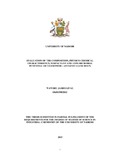| dc.description.abstract | In this study, the exudates of C. abyssinica were identified and collected from
different geographical locations in Kajiado County. Air-dried gum resin was ground
and then macerated using different solvent systems with varying polarities (hexane,
methanol and ethanol) in order to target different classes of compounds. The resultant
extracts were then subjected to antimicrobial assays including anti-bacterial and antifungal assays. The physico-chemical parameters of the gum resin from different
populations of C. abyssinica were determined to establish their potential application
in the agro-chemical industry. The oleo gum resin from the various locations was
found to have low moisture, ash and protein contents of 9.15-10.58%, 2.24-3.04% and
9.06-11.13% respectively. This resin contained 1.31 -1.87% volatile oil, 26-47% resin
and 82.25-84.50% water soluble matter. The ethanol extracts had saponification
values ranging from 171 to 176 mg KOH/g and an acid value of approximately 4 mg
KOH/g. This extract exhibited good foaming and surface tension reduction
capabilities, comparable to conventional synthetic detergent surfactants, and a low
critical micelle concentration (CMC) value of 36-40 mg/100ml at 22°C. The gum
formed a highly viscous solution and was found to stabilize emulsions at a
concentration of 0.1%, and the stability increased with increase in temperature to
60°C. The crude extracts obtained using hexane and methanol were found to consist
mainly of sesquiterpene compounds while those extracted with ethanol contained
sterols. The extracts were active against gram positive bacteria (Staphylococcus
aureus and methicilin resistant Staphylococcus aureus- MRSA) and one fungus
(Trycophyton mentagrophytes). Apart from the yield of ethanol extract, all the other
properties had insignificant variations, and therefore the mean values of the gum resin
samples studied from the different locations can be used to describe the general
characteristics of the C. abyssinica gum resin. Formulation of surfactant systems
using the ethanol extract can now be undertaken. A toxicological study should be
carried out so as to affirm the suitability of substituting some applications of gum
Arabic emulsifier with the water soluble gum extract from C. abyssinica. | en_US |

